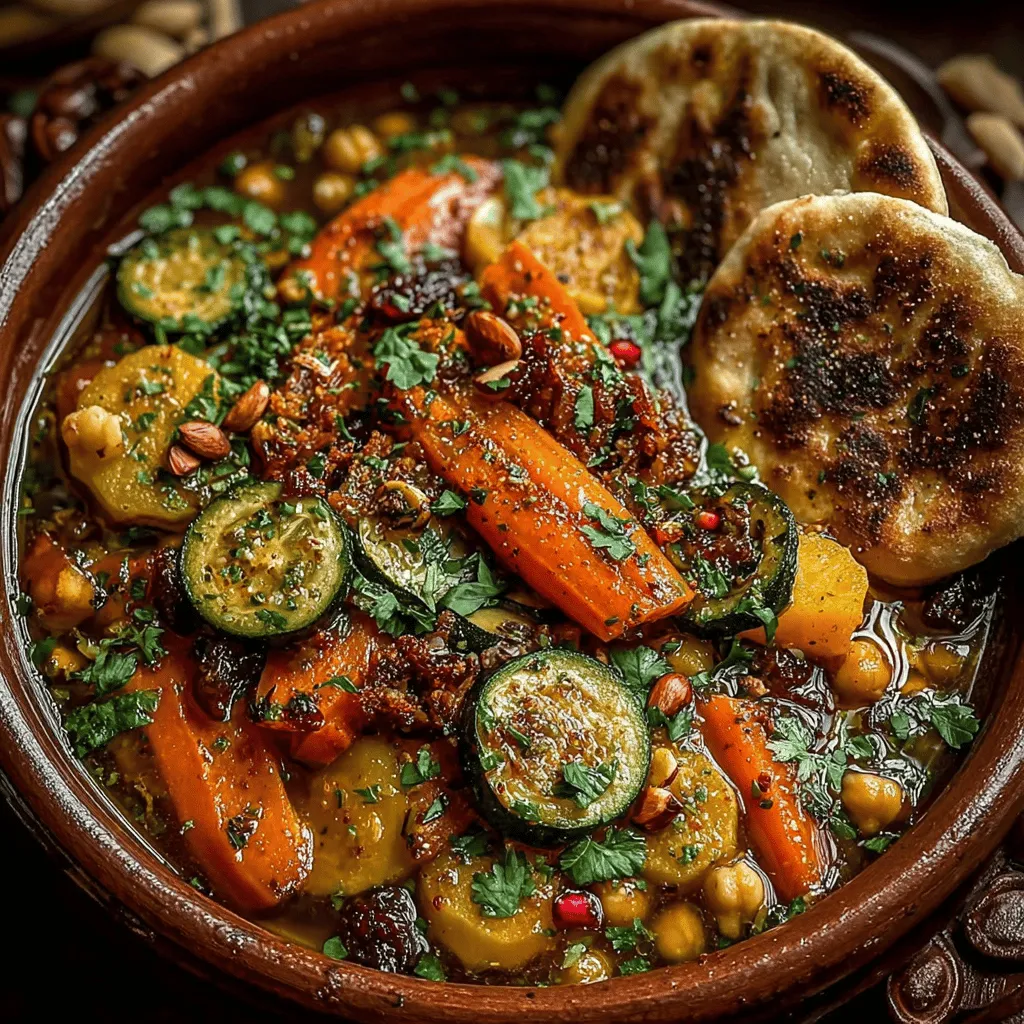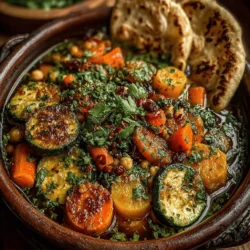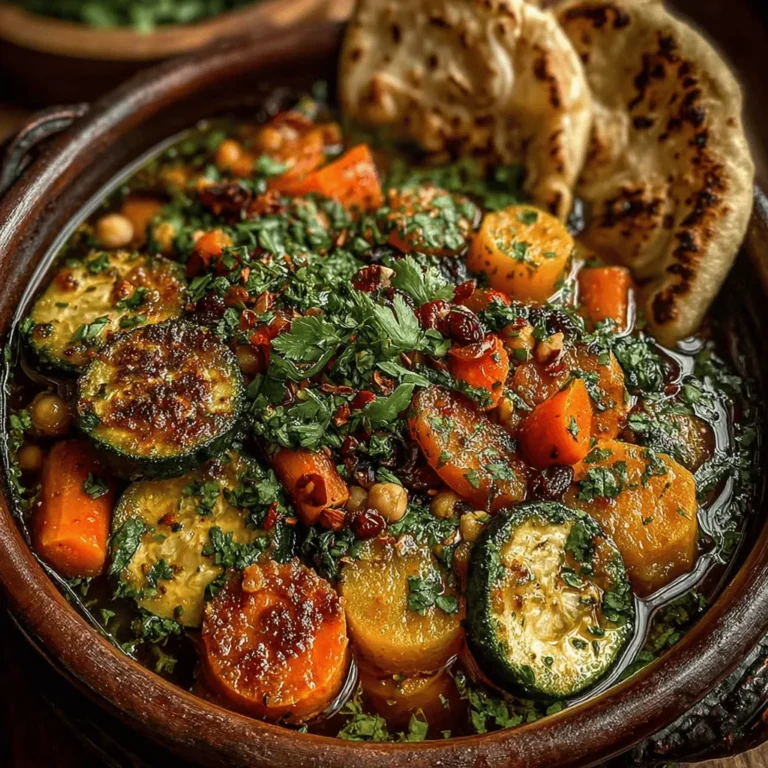Introduction to Moroccan Ember Harmony: A Slow Cooked Vegetable Tagine
Step into the enchanting world of Moroccan cuisine, where vibrant flavors and aromatic spices come together to create dishes that are both comforting and captivating. The Slow Cooked Vegetable Tagine, known as Moroccan Ember Harmony, exemplifies this culinary artistry. This nourishing, plant-based dish not only highlights the essence of Moroccan cooking but also promotes a healthy lifestyle. With its blend of fresh vegetables and fragrant spices, it serves as a perfect example of how to incorporate more plant-based meals into our diets.
The significance of the tagine extends beyond its ingredients; it is deeply rooted in Moroccan culture. Traditionally cooked in a tagine pot, this dish represents hospitality and community, often enjoyed with family and friends. The slow cooking method allows for flavors to meld beautifully, creating a warm and harmonious dining experience that is sure to delight the senses.
Ingredients
– 3 tablespoons olive oil
– 1 large onion, diced
– 3 cloves garlic, minced
– 1 inch fresh ginger, grated
– 2 large carrots, sliced
– 1 medium zucchini, chopped
– 1 bell pepper, diced (any color)
– 1 small butternut squash, peeled and cubed
– 1 can (15 oz) chickpeas, drained and rinsed
– 1 cup dried apricots, halved
– 1/2 cup raisins
– 2 teaspoons ground cumin
– 2 teaspoons ground coriander
– 1 teaspoon ground cinnamon
– 1 teaspoon paprika
– Salt and pepper to taste
– 2 cups vegetable broth
– 2 cups fresh spinach or kale, chopped (for serving)
– Fresh cilantro or parsley, chopped (for garnish)
Instructions
1. Heat the olive oil in a large tagine or Dutch oven over medium heat. Add the diced onion and sauté until soft and translucent, about 5 minutes.
2. Stir in the minced garlic and grated ginger, cooking for an additional minute until fragrant.
3. Add the sliced carrots, chopped zucchini, diced bell pepper, and cubed butternut squash. Sauté the vegetables for about 5-7 minutes until they begin to soften.
4. Incorporate the drained chickpeas, halved dried apricots, and raisins into the mixture, stirring well to combine.
5. Sprinkle the ground cumin, ground coriander, ground cinnamon, paprika, salt, and pepper over the vegetables. Stir to ensure the spices are evenly distributed.
6. Pour in the vegetable broth, bringing the mixture to a gentle simmer.
7. Cover the tagine or Dutch oven with a lid, reduce the heat to low, and let it cook slowly for 45-60 minutes, or until the vegetables are tender and the flavors meld together beautifully.
8. Before serving, stir in the chopped spinach or kale and allow it to wilt in the steam, enhancing the dish’s nutritional value.
9. Garnish with fresh cilantro or parsley for a burst of color and freshness before serving.
The Allure of Tagine Cooking
The Moroccan tagine is both a cooking vessel and a culinary method that has captivated food lovers for centuries. Its unique conical shape allows for efficient cooking, where steam circulates within the pot, enhancing flavors and textures. Historically significant in Moroccan households, the tagine symbolizes hospitality, bringing people together around a shared meal.
As you prepare this Slow Cooked Vegetable Tagine, you will not only embrace the traditional cooking style but also appreciate the communal aspect of enjoying this dish with loved ones. The tagine offers a perfect blend of convenience and flavor, making it an essential part of Moroccan culinary heritage.
Ingredients Breakdown for a Flavorful Tagine
Aromatics that Build Flavor
The foundation of any great dish lies in its aromatics. In this tagine, olive oil, onions, garlic, and ginger play a crucial role in creating a flavorful base. Olive oil adds richness, while onions provide sweetness and depth. Garlic and ginger introduce warmth and complexity, setting the stage for the vibrant vegetables to shine.
Fresh Vegetables and Their Benefits
The variety of fresh vegetables in this tagine not only enhances its flavor but also contributes to its nutritional profile. Carrots, zucchini, bell peppers, and butternut squash offer a colorful array of vitamins and minerals. Each vegetable adds unique textures and tastes, making every bite an exciting experience.
The Heart of the Dish – Chickpeas
Chickpeas are often considered the heart of Moroccan tagines, providing a robust source of protein for vegetarian meals. Rich in fiber and essential nutrients, chickpeas absorb the spices and flavors during the slow cooking process, ensuring that they meld harmoniously with the other ingredients.
Fruits for Sweetness and Depth
Dried apricots and raisins add a unique sweetness to the dish, balancing the savory spices. Their natural sugars caramelize during cooking, creating a depth of flavor that complements the earthiness of the vegetables and spices.
Spices that Define Moroccan Cuisine
No Moroccan dish is complete without its distinctive spice blend. In this recipe, ground cumin, coriander, cinnamon, and paprika come together to create a warm and aromatic profile. These spices not only elevate the dish’s flavor but also provide various health benefits, including anti-inflammatory properties and digestive support.
Final Touches for Flavor and Nutrition
To finish off this vibrant tagine, leafy greens such as spinach or kale are added just before serving. These greens not only enhance the dish’s nutritional value but also provide a fresh contrast to the rich flavors of the tagine. Optional toppings like fresh herbs add a pop of color and an extra layer of taste, making this dish as visually appealing as it is delicious.

Tips for Perfecting Your Tagine
Sautéing the Aromatics
When starting your Moroccan Ember Harmony, the sautéing of aromatics is crucial. This initial step not only adds depth to the flavors but also creates a fragrant base that enhances the entire dish. Use a combination of olive oil and butter to sauté garlic, onions, and ginger until they are golden and aromatic. This method releases essential oils and flavors, ensuring a robust taste profile as your dish cooks.
Vegetable and Spice Combination
Layering your vegetables and spices properly is key to maximizing flavor in your tagine. Begin with heartier vegetables like carrots and potatoes, followed by softer ones like zucchini and bell peppers. Sprinkle spices such as cumin, coriander, and cinnamon in between layers to allow them to infuse throughout the cooking process. This technique ensures that each bite of the tagine is packed with flavor.
Incorporating Liquid Ingredients
The liquid ingredients play a vital role in slow cooking, helping to meld the flavors while keeping the dish moist. Start by adding crushed tomatoes, vegetable broth, and a touch of honey or maple syrup for sweetness. The liquid should just cover the vegetables to prevent them from becoming mushy. Remember, the slow cooking method allows the liquid to reduce and concentrate, enhancing the overall taste.
The Art of Slow Cooking
Slow cooking is not just about convenience; it’s an art that brings out the best in your ingredients. Allow your tagine to cook on low for 6-8 hours or on high for 3-4 hours. This slow process helps the flavors develop beautifully, resulting in a dish that is both aromatic and comforting. The long cooking time also ensures that the vegetables become tender without losing their integrity.
Final Touches Before Serving
Incorporate fresh leafy greens like spinach or kale in the final 15 minutes of cooking to add a pop of color and extra nutrients. Adjust seasoning with salt and pepper, and consider a splash of lemon juice for brightness. These final touches not only enhance the flavor but also contribute to the dish’s visual appeal.
Serving Suggestions and Pairings
To truly elevate your dining experience with Moroccan Ember Harmony, consider serving it with fluffy couscous, nutty quinoa, or warm pita bread. Each of these options complements the tagine’s rich flavors and adds a satisfying texture to the meal. For beverages, Moroccan mint tea is a traditional choice that balances the spices beautifully, while a light white wine can offer a refreshing contrast.
Nutritional Benefits of the Dish
This slow-cooked vegetable tagine is not only delicious but also packed with health benefits. The variety of vegetables used provides a wealth of vitamins and minerals, such as vitamin A from carrots, potassium from potatoes, and iron from leafy greens. Additionally, the dish is high in fiber due to the vegetables and legumes, promoting digestive health while being low in saturated fat. This makes it an excellent option for vegetarian and vegan diets, as well as for those looking to incorporate more plant-based meals into their routine.
Conclusion: Embracing Moroccan Cuisine at Home
Moroccan Ember Harmony Slow Cooked Vegetable Tagine is more than just a meal; it’s an invitation to explore the vibrant and diverse world of Moroccan cuisine. By following the steps outlined in this article, you can create a dish that celebrates the rich flavors and cultural heritage of Morocco. Embrace the art of slow cooking and the health benefits of this wholesome dish, turning your kitchen into a hub of flavor and nourishment. Enjoy the process, savor the aromas, and share this culinary experience with family and friends.


